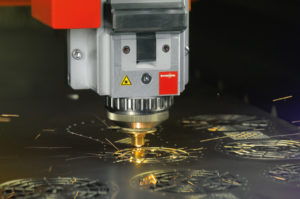The Real Costs
Often I come across older CO2 laser cutting, plasma cutting and punching equipment that is 10 plus years old and still in production. While there is something to say about running production on equipment that is already paid for, what are the real costs? What is the yearly cost to maintain the equipment, the consumable costs, the hard tooling costs, the electrical costs, the costs due to down time, the costs due to lack of productivity? When you factor in the real costs of running the older equipment and then compare it to new technology such as fiber laser cutting, the differences are staggering to say the least.
Fiber laser costs vs CO2 laser cutting costs
If you own an older CO2 laser cutting system then you quickly realize that you can produce 2 to 4 times more parts per hour with a fiber laser. The fiber laser reduces electrical consumption by more than 50%. There are no expensive mirrors to replace, as the fiber laser uses a fiber optic cable to both generate the beam and also deliver the beam to the cutting head. There is far less maintenance due to not having mirrors, beam path bellows, laser gas circulators or vacuum pumps. There are no start-up times as the fiber is effectively an instant ready-to-cut technology.
Fiber laser costs vs Plasma cutting costs
If you own an older plasma cutting system then you again realize that you can produce 2 to 4 times more parts with a fiber laser. The fiber laser requires nozzle changes approximately every 8000 pierces vs 500 pierces for typical plasma. The cost of the nozzle is 4 times less with a fiber and there are also no expensive electrodes to replace as well. Considering the time is takes to replace a nozzle and electrode set, times the cost, times the frequency of doing so, this equates to a lot of cost and lost production time. As your nozzle and electrode begins to wear, so do the quality of your cuts and the accuracy of your features. If you are still taking plasma cut parts and then moving the parts to a secondary machine for fine hole cutting, this adds to your overall costs. If you need to perform secondary finishing operations to your plasma cut parts this also adds to your overall costs.
Fiber laser costs vs Punching equipment costs
If you own punching equipment what are the costs of purchasing and maintaining hard tooling and also the cost of secondary finishing operations? What are the setup costs for the hard tooling and how can you justify single piece flows or low volume runs? How many more parts can you produce at a lower overall cost per part?
Justifying the Fiber laser Investment
Suddenly with a Fiber laser, you realize that you can produce 2 to 4 times more parts at half the cost and at the same time create more machine capacity to diversify into other markets or win more competitive bids with a lower overall cost per part. With new fiber laser machine offerings such as the new Bystronic BySmart Fiber, the lower cost of investments combined with the higher performance of the fiber laser, provides for a faster return on investment due to higher profits and higher revenue potentials.
By Frank Arteaga, Head of Product Marketing, NAFTA Region
Bystronic Inc., Elgin, IL – Voice.bystronic@bystronic.com

